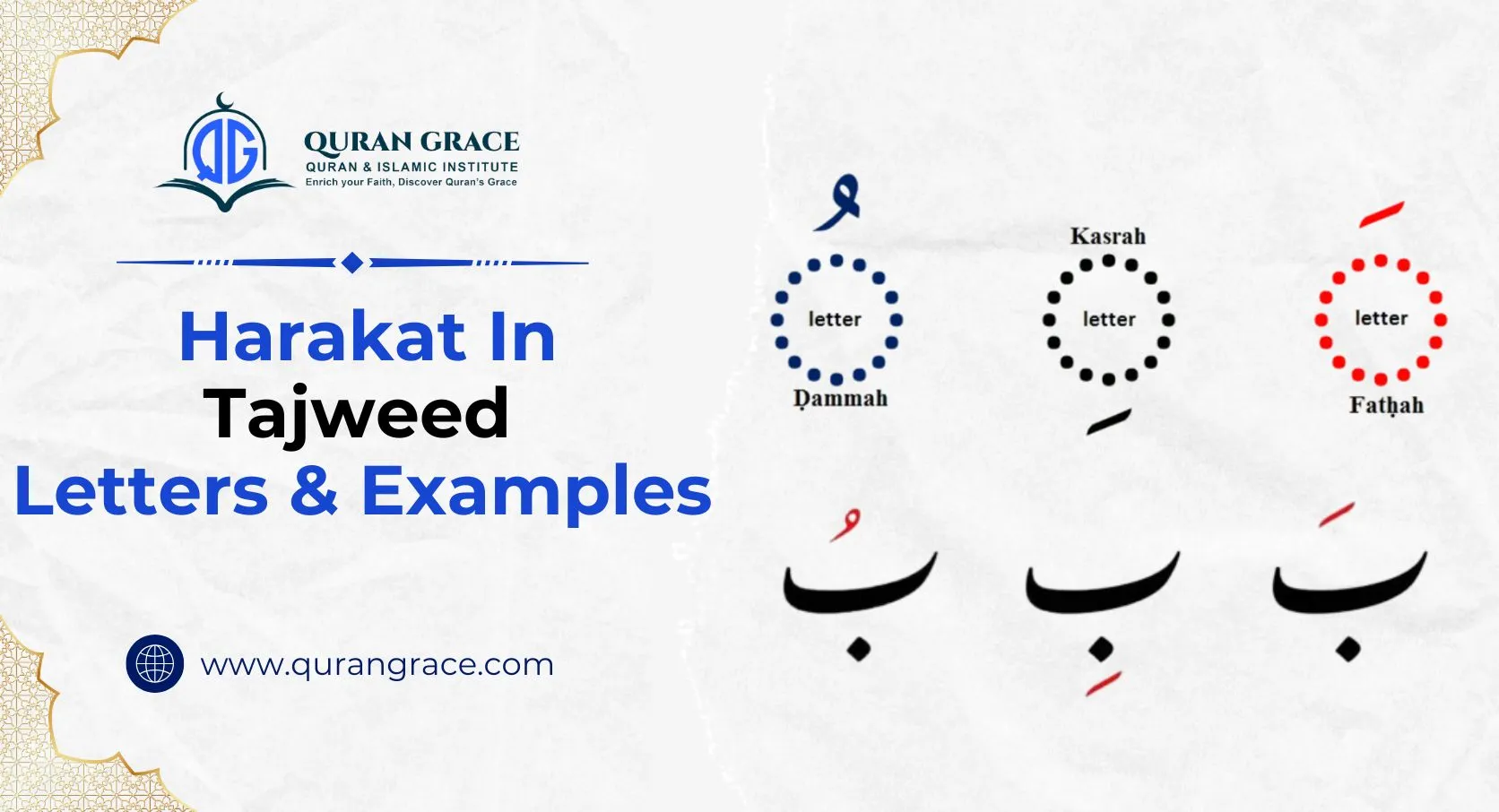Understanding the basics of the Quran requires familiarity with an essential component known as Harakat (حَرَكَة). These are small symbols placed above or below Arabic letters that alter their pronunciation. In this blog, we will explore the various types of Harakat found in Arabic and clarify the distinction between Harakat and Tashkeel. Additionally, we will provide Quranic examples of Harakat to illustrate their significance and usage in the text.
Table of Contents
ToggleWhat is Harakat?
“Harakat” originates from the Arabic root “حَرَكَة”, which means “movement.” These symbols are positioned above or below letters in the Arabic script and serve an essential role in guiding pronunciation. They indicate the correct sounds that should be produced, enabling readers to articulate words clearly and accurately. Mastering the use of harakat is crucial for Tajweed. This skill is particularly important for anyone looking to read and speak Arabic correctly, especially in the context of accurate Quran recitation.
Types of Harakat in Arabic
In the Arabic language, various forms of harakat (diacritical marks) are used to indicate different vowel sounds or phonetic changes essential for accurate reading, writing, and recitation. Understanding these harakat is crucial for mastering Arabic phonetics.
-
Fatha (َ)
The fatha is a small diagonal line placed above a vowel that signifies a short /a/ sound, similar to the “a” in “bat.” It is one of the most straightforward and commonly used harakat.
Example: “بَ” (ba) demonstrates that the letter “ب” (bāʾ) combined with a fatha produces the sound “ba.”
-
Kasra (ِ)
The kasra is denoted by a short straight line positioned before a consonant and indicates a short /i/ sound, like the “i” in “hit.”
Example: “بِ” (bi) shows that the letter “ب” (bāʾ) with a kasra results in the sound “bi.”
-
Damma (ُ)
The damma takes the form of a small loop above a consonant and represents a short /u/ sound, comparable to the “oo” in “book.”
Example: “بُ” (bu) illustrates that the letter “ب” (bāʾ) with a damma produces the sound “bu.”
-
Sukun (ْ)
The sukun is a small circle placed above a consonant, indicating that the consonant should be pronounced without a following vowel sound. It plays a significant role in the construction of syllables.
Example: “بْ” (b) indicates that the letter “ب” (bāʾ) with a sukun produces the sound “b” without any vowel.
- Shadda (ّ)
The shadda appears as a small “w” above a letter and signifies that the consonant it modifies should be doubled, effectively pronounced twice.
Example: “بّ” (bb) shows that the letter “ب” (bāʾ) with a shadda results in the sound “bb.”
-
Tanwin (ً,ٍ, ٌ)
Tanwin represents the phenomenon of nunation, which adds an “n” sound at the end of a word. It comes in three forms, each corresponding to the associated short vowel.
These harakat are essential for achieving proper pronunciation and meaning in Arabic, making them an integral part of learning the language.
Fathatain (ً): Adds an “an” sound to a word.
Example: “كِتَابًا” (kitāban) – “a book.”
Kasratain (ٍ): Adds an “in” sound to a word.
Example: “كِتَابٍ” (kitābin) – “in a book.”
Dammatain (ٌ): Adds an “un” sound to a word.
Example: “كِتَابٌ” (kitābun) – “a book.”
Refresh your harkat knowledge practically by joining advanced tajweed course today with Quran Grace.
Importance of Harakat in Arabic
The significance of harakat in the Arabic language is immense, as they play a crucial role in reading, writing, and comprehension. Here are some key reasons highlighting their importance:
- Proper Pronunciation: In Arabic, the meaning of words can change dramatically based on pronunciation. Harakat helps ensure that the correct vowels are articulated, aiding in accurate reading and understanding. Without these markings, readers may easily misinterpret texts, leading to potential confusion or errors.
- Beginning Arabic Language Instruction: For beginners, particularly those who are non-native speakers, harakat serves as a valuable tool for grasping the language. They help learners comprehend the structural aspects of Arabic and provide guidance for proper pronunciation.
What is the Difference Between Harakat and Tashkeel?
Tashkeel is a system of diacritics used in Arabic writing. It shows how to pronounce letters. It’s key for reading Arabic text correctly, especially for those new to the language.
“ٱلْحَمْدُ لِلَّهِ رَبِّ ٱلْعَـٰلَمِينَ”
In this verse, the Tashkeel (diacritics) are shown by signs like:ًّ ْ ُ ِ ّ
Tashkeel helps readers read words correctly. It improves Harakat’s accuracy. So Tashkeel is the written sign, while Harakat is the practical aspect of the language.
Conclusion
To master the key concepts of Harakat and Tashkil, you are welcome to join the online Quran Tajweed classes at Quran Grace. The native Egyptian tutors here will help you understand the harakat with animation and the latest tech-based resources, making each rule easy to understand. You can join our free evaluation class and see how the practical Tajweed classes work.








